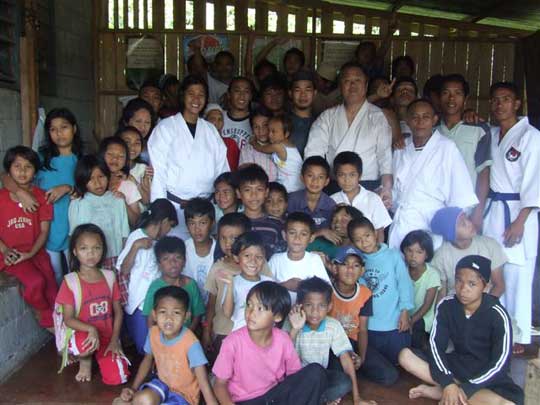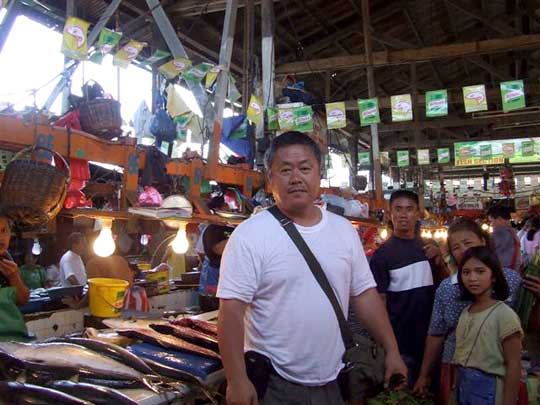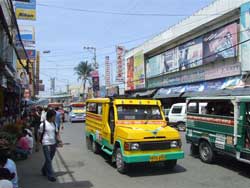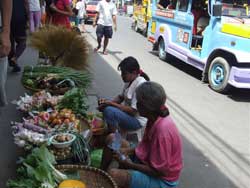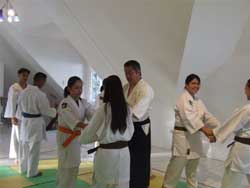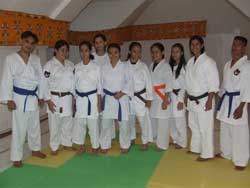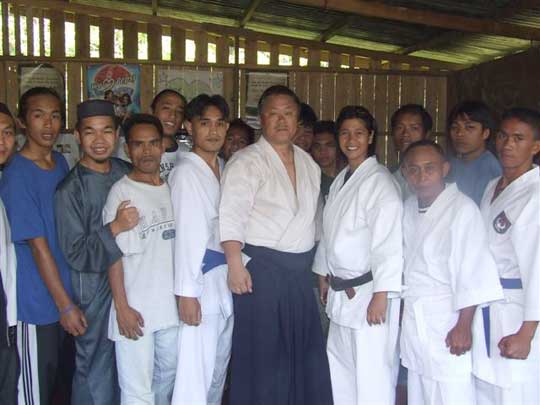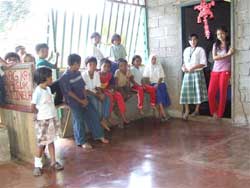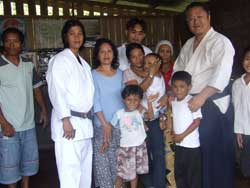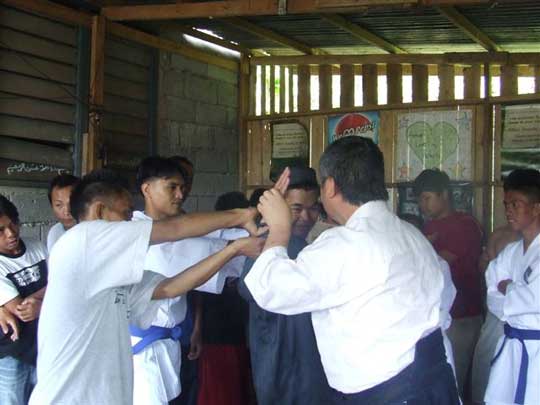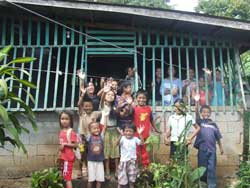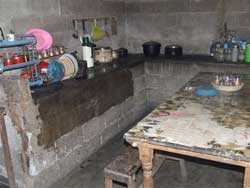Written by Gaku Homma
April 15th, 2007
In mid-February 2007 I set out on a thirty two day journey through South East Asia with visits to Mongolia, the Philippines, Nepal, Bangladesh and India; five countries in all! On this trip as others, I met many wonderful people and had a variety of incredible experiences. I had been to most of these countries on previous occasions, but this was my first visit to the Mindanao islands in the Philippines. This article is about my experiences there.
Before I tell you about my experiences in the Mindanao Islands, I have an “appetizer” story for you.
On this journey I was told a story about a man and his wife, both born into royal families from two neighboring countries. The man and his wife live together as part of the aristocracy in his native country and have two children. As it would happen, this royal family fell in love with the martial art of Aikido and had planned a one month visit to Japan to practice Aikido at Aikikai Headquarters (Hombu Dojo) in Tokyo. Last year, the family visited Japan to practice Aikido and took up lodging at a five star hotel in a very exclusive section of Shinjuku, near Hombu dojo. Everything about the trip was unbelievably luxurious. Their hotel suite included one room for the couple, one room for the children, and an additional room for the attending maid. The price tag for one night at this hotel was $3000.00 per night, PER ROOM! This did not include the cost of meals, transportation or other travel expenses. Half way through the trip last year, the family was joined by the grandparents, adding an additional room to the suite of rooms they occupied. By rough estimates, the family was spending approximately $10,000.00 per day or $300,000.00 for the month to practice Aikido in Tokyo! I was told this story by the guide that will accompany the royal family to Tokyo on this year’s excursion, and on this upcoming trip his and his entire family’s expenses will also be covered.
Being a part of a royal family is somewhat unimaginable for the rest of us, and it is difficult to imagine the level of accommodations that are required for a family of such lineage. It is a great gift that a family of this standing supports Aikido and does so much to support the development of Aikido in their country back home.
This reality is far from the reality that most of us as Aikidoists lives and practice. For some Aikidoists, it is as far away as the earth is from the sky.
**********************
One hour southwest by plane from the capitol city of Manila in the Philippines is the city of Cagayan de Oro in Mindanao. Cagayan de Oro is commonly referred to as CDO and has a population of about 500,000 people. About three hours southwest of CDO by car on the coast is the city of Iligan. Iligan City is located in a predominantly Muslim area that is largely depressed due to many difficult social and political factors. Resistance groups such as the MNLF and the NPA are active in the area and at times it can be a volatile place to be. I was told as we neared Iligan that skirmishes have been known to break out in this seemingly peaceful area at any time.
- Easy going downtown Iligan.
- Women selling vegetables.
It was my first impression being a first time visitor to the area that the people here were very relaxed and friendly and the surrounding mountains, countryside and coastline were quite beautiful. The kind of underlying unrest I had been told about was not readily apparent to me. I was met at the airport in CDO by Ava and other students who practice Aikido in Irigan City. Ava also practices other Chinese martial arts and is highly ranked in these arts, having won many national Philippine competitions. She showed me pictures of her accomplishments in albums she keeps.
Ava is very interested in Aikido and has taught herself from books and tapes. The Aikido she practices has a sense of interpretation to it based on the fact that she is mostly self taught. Why is Ava interested in Aikido? Ava is very enthusiastic about practicing Aikido because the practice of Aikido does not revolve around hitting, kicking or hurting your partners. For her, Aikido is a peaceful martial art, compared to the other martial arts she has practiced. From what I was learning, Ava lives in an environment where violence and war can erupt at any moment; she knows first hand the effect this kind of volatile environment can have. Ava has a true understanding based in real living experience, and has seen the hope and peace that the philosophy of Aikido can bring. Ava is also a very devout Christian and in her home there is a larger than life sized statue of Maria. It is here that she cares for young girls and martial art students in the neighborhood, sharing with them a message of peace.
Ava and her students were very happy that I had come to their remote city of Irigan. I was introduced to everyone over and over as “Aikido, Gaku Homma”. I was personally introduced to shop keepers in the fish markets, meat shops; practically everyone we met. For a moment I felt like I should have been running for office! If I had been a movie star named Steven, maybe some of these people would have known who I was. I found it heart warming as I was introduced proudly to a grandmother in a vegetable shop who most likely had no idea what Aikido was. It was quite a thoughtful gesture however and everyone greeted me with enthusiasm, smiles and waves. It was quite touching.
- Homma Kancho teaching Aikido at Ms. Alia’s home.
- Students at Alia’s home.
The young ladies had been practicing Aikido with Ava for some time. Their manners and movements were pretty good, if not quite classic Aikido movements. Alia told me that since kicking and punching were not focused on in Aikido and the movements were peaceful in nature, that this was a good martial art for these young girls to practice. It was for this reason that she offered this space in her home for Ava to teach the girls. The girls were also interested in Japanese language studies and had learned a few words from Japanese animation videos. The words they had learned were “cute Japanese” words that made me smile hearing them so far away from Japan. After practice, Alia served cakes and drinks to all of the students and guests. Our refreshments finished, the girls were again picked up by private cars and whisked away to there homes. I felt more like I was in a private club than a dojo but I was proud of what Ava had started.
*****************
The next day I had planned to return to CDO to prepare to teach a seminar there. The schedule was changed however, and instead I soon found myself on a forty five minute taxi ride to the village of Marawi. I need to explain the reason why I was interested in visiting Marawi. My nose was peeling and my face was tan before I came to the Iligan area, just returning from a joint military medical mission accompanied by 100 soldiers from the United States Army and the Philippine Army to two local villages deep in the jungles. For more about this part of my Philippine experience, link here to my new article “Returning Home, the True Mission of the Samurai. Joint United States and Philippine Military Medical Mission Eyewitness Report”.
While in Iligan I met a student of Ava’s named Saidamen, who was born and raised in Marawi. Saidamen was no stranger to the skirmishes and fighting between factions in the area and teaches martial arts himself to children and young people in his home town. He asked me if I would like to visit his home in Marawi and see where he taught his classes. I wanted to see Marawi but the people of Iligan warned me against it in a serious tone. “It is dangerous there” they said. “You might get kidnapped”. Ava countered sharply. “You are discriminating negatively against the people in Marawi. I go to Marawi every week to teach and nothing has ever happened to me. This attitude is part of the problem between our cities. Saidamen is a leader in Marawi and Homma Sensei will be an important guest of his. Nothing will happen to him!” Ava showed her leadership skills with day and I could see why she was becoming an important leader in her community.
I had been told that Marawi’s economy was depressed even by Mindanao standards, and that it was not safe there. Even the taxi driver we approached for the trip did not want to go there. We heard through the grapevine that there was one particular taxi stand where drivers might be willing to embark on this journey and we headed in that direction. Ava and Saidamen did the negotiating and I made sure I stayed out of it, leaving it in their hands. Soon we were on our way together to Marawi by taxi.
After almost an hour on the road, passing villages along the way through the countryside we arrived in Marawi and headed for Saidamen’s dojo. The dojo was built out of the side of a hill tucked between clusters of houses. The dojo was the size of a six tatami mat space. The floor was made of concrete that had turned black over the years with the oils from many bare feet. The roof consisted of open aired eaves made of corrugated tin, and the building also included the dwelling where he and his family lived.
- Curiosity wins over local Marawi children.
- Practice at the Marawi dojo.
*****************
I have been to many dojos in many places, especially to dojos I refer to as “front line dojos” in developing countries around the world. It has been my mission to visit these pioneer instructors no matter what the size of their dojo or the number of students. In my mind, when I think of a “front line dojo” I think of a drop of black ink dropped onto a piece of rice paper. As the blot is absorbed the spot grows on the paper widening outward. The most outer edge of the ink spot is where I imagine “front line dojos” to be. These “front line dojos” are so far away from the center of mainstream Aikido that sometimes the lines between Aikido, Karate, Jujitsu and other martial arts are not all that clear. These dojos are still raw, and vital and young like molten lava; not yet solidified into a solid form.
After the Meiji Revolution in Japan, people sometimes wore Japanese kimono and hakama with western styled leather shoes, silk top hats and cane umbrellas! There was a blending of cultures in progress for the beginning of this new era. This is the kind of image that comes to mind when I think of the variations of Aikido and other martial arts that are sometimes practiced out here in these dojos on the front lines.
I have watched martial artists in Bangladesh do break falls on a crumbling, uneven brick courtyard floor. I have seen earthen dojo floors in Vietnam covered with patchwork mats made from potato sacks stuffed with coconut tree bark. I have met students in Nepal who go to school by day, work by night, and practice Aikido by candlelight before dawn. I have practiced Aikido with students in Nicaragua who without a dojo to call their own, practice at the bottom of an empty swimming pool and on a basketball court. I know of students in Mongolia who practice without heat throughout the Mongolian winters where skin freezes to metal with a single touch it is so cold. Many times I have witnessed the efforts of these front line martial artists and practiced in their dojos. Each of these martial artists are keepers of a small flame; keeping the study of the martial arts alive for future generations with the seriousness of their pursuits. They are why I go on these journeys. I go there personally, to meet and see the efforts of these people with my own eyes, to offer what I can in support of their efforts with my person.
In most of these areas, Aikido instruction books and videos are not available and instructors do not visit. What these people know of the martial arts they have mostly learned from movies. As an introduction to Aikido, most students have watched the “pony tailed Hollywood star” use kotegaeshi, kicks or punches to throw a bad guy out of a window or over the counter in a bar. There are many very sincere martial artists that I have met on the front lines that believe this portrayal of Aikido to be true. Whenever I visit the front lines to teach Aikido I always have to keep it in mind that I might be challenged, that students might be thinking that Aikido is like it is presented in the movies they have seen. This unrealistic portrayal of Aikido by a certain Hollywood star increases the chances for a dangerous encounter. I have seen many movie posters in far away places for the pony tailed Hollywood actor’s action films. Sometimes next to these posters featuring our Hollywood star I have seen collages made from internet photos of a certain Aikikai Headquarters International Aikido Federation head Shihan. Portraying these two side by side I feel is damaging to the overall image of Aikido as these photos infer that violent Aikido is officially condoned. It is also damaging that this International Aikido Federation Shihan also uses photos of the Hollywood actor in his own seminar advertisements overseas which further confirms his approval of the propagation of a violent image for the art.
Students on the front lines think that the Aikido portrayed by Hollywood is real. For those that agree with this position I suggest they enter a full contact open tournament with some of these diligent martial artists on the front lines. That would set the record straight.
*****************
People began to gather at Saidamen’s dojo as we arrived. First the children came, followed shortly by the older boys. Finally some of the village elders arrived led by an elderly gentleman wearing a home-made keiko gi and hakama. The village leader had come to check us out!
I taught class, but the space was small and the inside of the dojo was completely packed. Even though it was extremely hot and humid, I wore my keiko gi and hakama out of respect for everyone who had come and because these student rarely if ever have a chance to see a traditional uniform. There was no space to practice any kind of ukemi, and there was the cement floor to consider, so we practiced standing release techniques (tehodoki) and standing lock techniques (tachigatame). The students stood shoulder to shoulder so with this little space these techniques seemed appropriate and were well received.
Saidamen’s dojo served as a meeting and gathering place for the village young people to exchange news, talk and learn from one another. It was also a place for them to release some of the youthful energy they all possessed with vigorous martial art practice. This reminded me of my days as a boy in Japan where it was also common for dojos to be a local gathering place for growing boys and young men.
The visit to Marawi was a very valuable exchange for everyone. Beyond race, religion or nationalism together we built the beginning of an understanding and trust that I believe in. Through the looking glass of our Aikido perspective, Saidamen is doing well as a young leader in his community. I hope to be able to support his efforts and help him build his activities in Marawi well into the future.
- Local leaders and Homma Kancho.
- All the children waving goodbye.
When it was time to leave the dojo, dozens of children, students and elders gathered around the taxi to bid us farewell. A few of the kids even ran after the car as we pulled away. I never felt an inkling of the supposed danger that the world has been watching for in this area. The memories I came away with from Marawi were that of very innocent country people who went out of their way to be kind and generous to me. I will never forget the gentle hearts of the Muslim people I met there.
To Saidamen and others who practice in front line dojos everywhere I want you to remember another story.
Twenty years ago, I was taken to a place in Northern Japan where the Founder of Aikido, Morihei Ueshiba himself had taught forty years before. I was surprised to see that it was actually a small barn with a bare earthen floor about ten tatami mats in size . If the horses that lived in the barn were to put their heads out of their stalls while students were practicing with the Founder, they would have knocked someone over it was so small. The earthen floor was covered with a thinkamasu (rice straw mat) where the ten or so students would gather to practice under the Founder.
It was from these humble beginnings that Aikikai Aikido’s Akita Prefecture’s branch was born. Aikikai Akita Aikido is now very large, and today the area where this barn is located is crowded with houses, but when I was a child in Akita this was just a small village far from the downtown streets of Akita City. I reflect now on the thought that the Founder came to this area at all. In those days it would have taken him about thirteen hours by train to get there. We don’t know now why he came to this poor local area in Northern Akita Prefecture but it is a great reminder to all of us that Aikido was not born in a dojo as big or as rich as a castle. Aikido in Akita Prefecture began in this small village, in this tiny dojo by an Aikido pioneer named Ueshiba. This is a very important thing to remember, for at one time this dojo was a front line dojo as well.
- Dining room in Alia’s home.
- Dining room in Saidamin’s home.
Different life styles; Different meaning and purpose for practicing Aikido.
On this journey through Asia I had many opportunities to meet both with “kings” and with simple people from the smallest of villages. It is not that one is good and one is bad. Personally, I am most drawn to the people I have met who are searching in their practice of Aikido for ways to help in their own lives and to help their own communities through the problems and obstacles of political unrest, religious discord, and economic hardships. The people I met on this journey are making progress; sometimes small but in a very real way.
Between Earth and Sky.
In our own lives, we all stand tall, reaching for the sky. It is considered a virtue in our society to always be challenging ourselves to go higher and higher; to reach for more and more. If we are to reach this sky, I believe that we must first be standing firmly on the ground. We need to be able to see exactly where we are standing, to have a foundation based in reality. If we can truly see where we are standing, we can also more clearly understand the value of the martial art we practice. There is a difference between the pursuit of the true spirit of martial arts and the pursuit of fighting prowess. To truly understand, we need to explore the philosophy behind the art; true martial art training is not about fighting bloody competitions to win it is about understanding. Reaching the sky depends greatly on knowing where on the earth you stand first.
*****************
I left Iligan to return to CDO where I practiced Aikido with Alexander Y Javier Sensei at the Mindanao Aikido Propagation Center. It was soon time for me to leave for the next part of my journey and it was time to say goodbye. At the airport I said farewell to Ava, Saidamen and Benny who had been my constant companions in Mindanao. All of their eyes were shining as we said our farewells. As I turned to go, I could almost hear the sound of tears falling behind me. I did not trust myself to turn around and wave my final farewell until I was well down the terminal unless they see mine.
To Ava, Saidamin and Benny, my hopes are that you will continue your leadership in your communities. Take care of your elders and be a role model for the young. Try your best. The hard experiences and tough life you live today will bring you wisdom and serve you well in the future.
Thank you to everyone in Iligan and Marawi for your kindness. I am very happy I had the chance to meet you.
I have something to ask of all Aikidoka who read this article. In many countries, there is a great need for used Aikido books; especially Aikikai Aikido and Yoshinkan Aikido books are needed. It does not matter if the books are written in Japanese or English, pictures speak a thousand words, so books with lots of pictures are the best. Books are needed for front line dojos in areas where eager students and even instructors do not have the financial resources to attend established dojos or there are none available in their area.
If you have any books you would like to donate, please write a personal message in the cover if you would like and send them to AHAN at:
AHAN Used Book Distribution Project
Nippon Kan
1365 Osage
Denver, Colorado 80204
Written by Gaku Homma
Nippon Kan Kancho
March 20th, 2007
Note from AHAN Headquarters: On February 26th, 2007, Homma Kancho personally donated (60) new 3 ft square jigsaw gym mats to the students in Iligan and Marawi.


